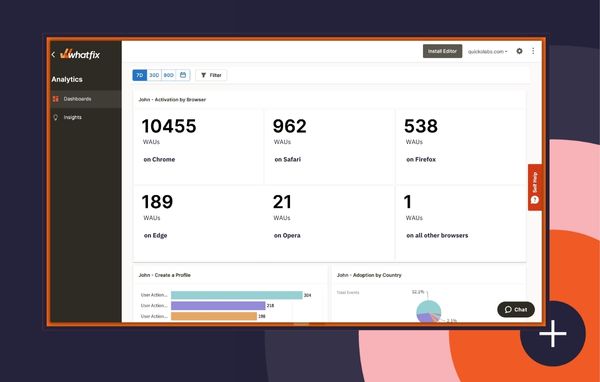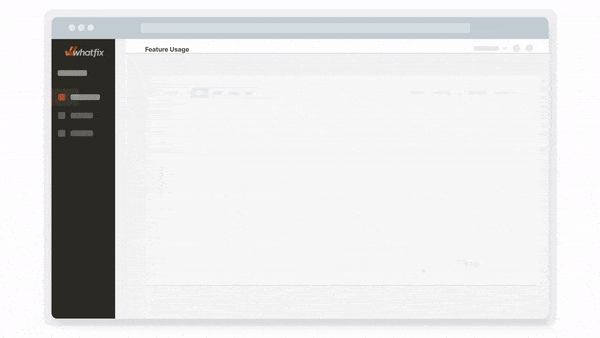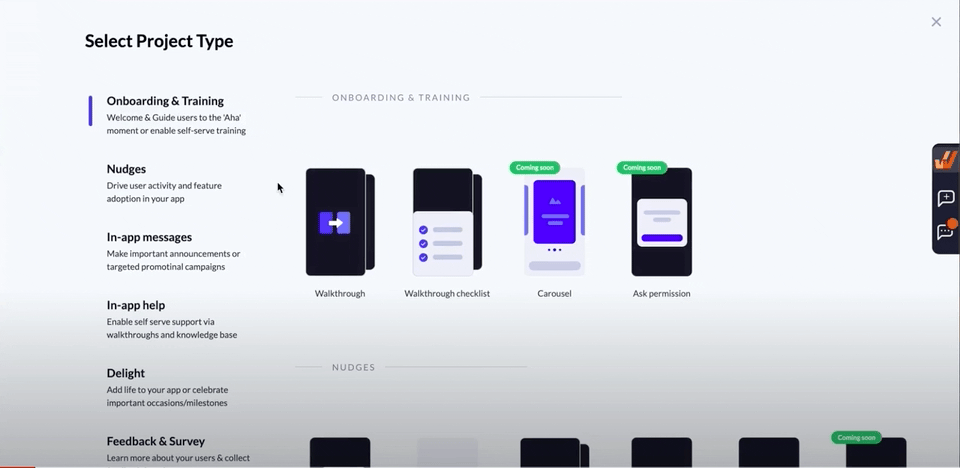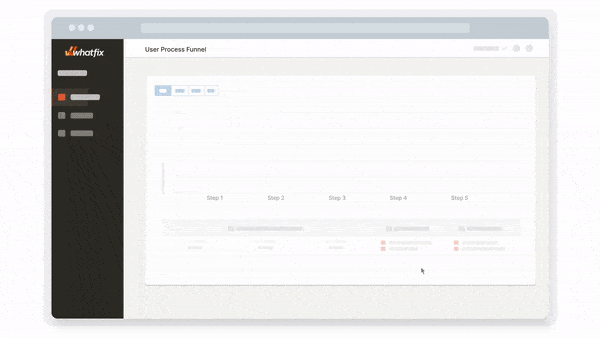15 Must-Track Product & User Adoption Metrics (2024)
- July 13, 2022
- Updated: April 16, 2024


Developing a product that users love depends on constant refinement and improvement. Tweaking your product to align with your customer’s needs and expectations encourages sustainable growth — but updating and changing your product is expensive and time-consuming.
Investing your time and money into making changes that will improve your user experience is essential. Data, behavior, and product analytics are the best ways to discover where those opportunities lie.
Let’s walk through the most critical metrics to track for improving your product adoption in 2022.
What are the most important product and user adoption metrics to track?
- Product adoption rate
- Feature adoption rate
- Time-to-value
- Time-to-first action
- Onboarding completion rate
- Daily active users (DAU) or monthly active users (MAU)
- Usage frequency
- Net Promoter Score (NPS)
- Customer or user churn
- Customer or user retention
- Customer lifetime value (CLV)
- Customer satisfaction (CSAT) score
- User feedback volume
- Activation rate
- Average session duration
What Is Product Adoption?
Product adoption (also referred to as user adoption) occurs when a user begins to use your product as intended, and fully understands the tool’s value. Product adoption is typically the final conversion in turning a lead into a customer. It goes a step further than just acquisition to encompass activated and retained users.
Product adoption is measured after a user performs a certain action. However, that action varies from platform to platform. The action should show that the user is getting value from your product.
For example, a new user signs up for your product, and you count that individual towards your acquisition rate. But after signing up, they never log in to your platform or app again. Although they might still be considered a user, they haven’t adopted the product because they’re not using it.
Setting your product adoption benchmark to be a behavior beyond just signing up helps you track clients getting real value from your product.
Benefits of Measuring Product and User Adoption
Measuring product and user adoption give you deeper insight into how you connect with your customers and audience. If you only tracked surface-level metrics like sign-ups or acquisitions, you might be missing key information about how engaged your users are. Underserved or unhappy users might fly under your radar and move on to a competitor before you realize they’re not engaged.
Tracking product and user adoption can help you determine if you’re reaching the right audience through marketing and sales efforts and discover new opportunities for keeping acquired customers happy with your product and active on your platform. You’ll make decisions aligned with your audience’s long-term needs, so you can build sustainable relationships that help your company grow and scale.
15 Most Important Product and User Adoption Metrics to Track
Ready to start measuring product and user adoption KPIs? Here are the top metrics to track.
- Product adoption rate
- Feature adoption rate
- Time-to-value
- Time-to-first action
- Onboarding completion rate
- Daily active users (DAU) or monthly active users (MAU)
- Usage frequency
- Net Promoter Score (NPS)
- Customer or user churn
- Customer or user retention
- Customer lifetime value (CLV)
- Customer satisfaction (CSAT) score
- User feedback volume
- Activation rate
- Average session duration
1. Product adoption rate
Product adoption rate is the number of users who adopt your software compared to the total number of signups or new users within a specific timeframe.
To find your product adoption rate, use the following formula:
Product Adoption Rate = (New Active Users / Total Signups) x 100
For example, if you have 100 sign-ups within your designated time frame, but only 50 of them are active, your product adoption rate would be 50%.
Product adoption rate is great for determining how successful you engage and retain the users you acquire, but it also highlights how many new signups you risk losing. In this example, 50% of your sign-ups have not been active and are likely to end their relationship with you. With the product adoption rate, you can identify how many new sign-ups you need to convince to stay and improve your retention plan accordingly.
Analyze user behavior and track product usage with Whatfix Analytics
Enable your product managers to easily track and analyze user behavior and product usage with Whatfix Analytics, a no-code event tracking solution. With Whatfix Analytics, capture all user actions without engineering support, understand product usage, identify dropoff areas, understand feature adoption, map user journeys, build user cohorts, and make data-driven product decisions.
2. Feature adoption rate
Feature adoption rate is similar to product adoption rate but looks at the number of users who actively use a specific feature.
The formula for finding feature adoption rate is similar to product adoption rate. It looks like this:
Feature Adoption Rate = (New Feature Users / Total Users) x 100
With your feature adoption rate, you want only to count the total number of active users — not your total signups. This will give you an idea of how many engaged customers are taking advantage of a particular feature you’re offering.
Knowing your feature adoption rate tells you how well a particular feature resonates with your users. A low feature adoption rate could indicate that your users don’t need that function or that you need to put more effort into marketing those features and educating your audience on how to use it.
3. Time-to-value
Time-to-value is the time it takes for a user to realize the true value of your product or the amount of time it takes to properly onboard a new user and bring them up to speed with your platform. They reach “value” when they start to see a return on their investment.
Measuring time-to-value can’t be done with a set formula. To find your time to value, you first must define what action represents reaching value for your users. Value might be achieved after completing an onboarding process, uploading specific data, or actively using the platform for a set amount of time.
Once your value behavior is set, simply count the days between becoming a customer and reaching value to find time to value. For example, if users achieve value after completing onboarding and a user takes four days to get through the onboarding process from the day they sign up, your time to value would be four days.
If time-to-value is too long, you risk users becoming disinterested and moving on to a competitor. When time-to-value is short, customers will realize the return on their investment faster, increasing loyalty and retention.
4. Time-to-first action
Time-to-first action measures the time it takes a new user to engage with a particular function or feature.
To find time-to-first action, you first need to identify what action you’re measuring.
Then you’ll want to count the days between when that user became a customer and when they performed the particular action you’re measuring.
Time-to-first action can help you better understand customer needs, how well you’re onboarding users, and measure product stickiness. If users take a particularly long time to engage with a specific feature, it could indicate that they’re uninterested in that functionality or that they’re not sure how to use it (or, in some cases, that it is even available to them in the first place).
On the other hand, a short time-to-first action can help you identify the features that are most beneficial to your users. When you know what actions users take when they first become users, you can build your onboarding program around getting them up to speed faster and improving your time-to-value.

5. Onboarding completion rate
Onboarding completion rate tells you the number of users who reach the end of your onboarding process.
You can use the following formula to find your user onboarding completion rate:
Completion rate = # of users who completed onboarding / total # of users who started onboarding
The easiest way to track and measure your onboarding completion rate is with a tool that offers product analytics. Analytics will not only let you measure how many users complete your onboarding process but also highlight areas where users might drop off. Identifying the weak points of your onboarding process will help you create a more engaging system that converts more users.
A low completion rate could also indicate that your sales team isn’t reaching the right audience. If you’re struggling to increase your onboarding completion rate even after making process adjustments, it might be because the people starting the onboarding process aren’t interested in the tool once they become more familiar with it.
6. Daily active users (DAU) and monthly active users (MAU)
Active users tell you how many users are engaging with your platform or service within a specific time period (in this case, daily or monthly).
To find your total number of active users, first identify the time period you want to measure and track how many unique individuals log on or engage with your platform that day.
Daily active users (DAU) measure the “stickiness” of your platform, or how much your users depend on your product or platform daily. A high number of daily users means your audience base is engaged and benefits from using your platform.
Monthly active users (MAU) is typically used to measure platforms or products that might not be necessary to check in every day. For example, you might measure website traffic in monthly active users.
In addition to being great indicators of company success and performance, knowing your DAU and MAU will come in handy for tracking other metrics and KPIs, such as customer lifetime value (more on that later).
7. Usage frequency
Usage frequency looks at how often a specific account is used. This often goes hand-in-hand with DAU or MAU but looks at individual accounts instead of your user base as a whole.
It’s best to measure product usage frequency during a set period, not necessarily for the entire lifetime of the user. For example, if your user was active every day when they first signed up, but their usage fell off recently, this could indicate that they’ve permanently solved the problem your platform was designed to fix or that they’ve moved on to a competitor. But if their user count is high, their drop-off could go unnoticed.
Look at usage frequency per week, month, or even quarter. A high usage frequency will show you who your best customers are and who might need some additional attention or support to reach the full value of your product.

8. Net promoter score (NPS)
Your Net Promoter Score (NPS) is a customer experience metric that helps predict business growth.
To find your NPS, you’ll need to survey users with the following question: How likely would you recommend [brand] to a friend or colleague?
You’d then ask your users to rate their likelihood on a scale of 1-10. Scores between 0-6 are considered Detractors, while scores 9-10 are Promoters and 7-8 are Passives. Subtract the percentage of Detractors from the percentage of Promoters to find your NPS. Scores can range from -100 to 100.
NPS is an easy way to measure customer satisfaction, but it’s usually not specific enough as a standalone survey. It’s short and to the point, increasing the likelihood that users will engage, but without follow-up questions or context, it’s hard to know exactly why a customer might be a Detractor or Passive.
With Whatfix, product teams can create in-app NPS prompts – as well as other, targeted, in-app user survey prompts – with no development support, to collect feedback in real-time.

9. Customer or user churn
Customer churn rate refers to the number of customers or users who stop using your product or platform during a specified time period.
To find customer or user churn, use the following formula:
Customer churn = Number of customers lost during a time period / Number of customers at the beginning of that time period x 100
For example, if you started a new quarter with 500 customers but ended with 400 customers, your churn rate would be 20%.
Churn rate is important because it tells you how well you’re connecting with your customers and how well you’re retaining them. Even if you’re replacing those customers who left, if your churn rate is too high, it will become nearly impossible to grow at a sustainable rate.

10. Customer or user retention
You have customer and user retention on the flip side of customer and user churn. Customer retention is the percentage of customers who remain customers during a specific period.
The formula you use to find customer and user retention is similar to the formula to find churn:
Customer retention = Number of customers at the end of a time period / Number of customers at the beginning of the same time period x 100
In the same example above, your retention rate would be 80%.
In an ideal world, you would have a 100% retention rate. However, it’s common to lose a customer here and there. A high retention rate tells you that you’re meeting your customers’ needs and they’re satisfied with the support you’re giving them.
On the other hand, if your retention rate is low, it’s likely an indication that customers are unhappy or a competitor is offering a better service. You can conduct a retention analysis to uncover why customers are churning.
11. Customer lifetime value (CLV)
Customer lifetime value (CLV) represents a customer’s total business value during their relationship with your brand.
The simplest way to find your CLV is:
Customer lifetime value = Total purchases during customer lifetime – cost to acquire and service customer
For example, if a customer spends $2,000 with your company over their lifetime and it costs you $400 to acquire and service that customer, the CLV of that customer would be $1,600.
CLV gives a long-term view of the value customers provides your business. It’s easy to get excited about large purchases or long-term customers, but until you compare the amount of revenue they’re bringing in with the costs associated with them as a client, it’s hard to tell if you’re actually growing your business or just treading water (or even losing money).
Measuring CLV can also help you monitor your customer engagement yearly. You might find that customers tend to spend more in the early days of their relationship with you, or their spending might ramp up as they become more comfortable as a customer.
12. Customer satisfaction score (CSAT)
Customer satisfaction score measures overall customer satisfaction with your product or service. This score is based on a survey or feedback mechanism that calculates the number of satisfied customers within a group of respondents.
To calculate CSAT, use the following formula:
CSAT score = (number of satisfied customers / total number of respondents) x 100%
This number provides insight into how well your product meets customer expectations where a higher percentage means greater customer satisfaction.
13. User feedback volume
User feedback volume refers to the quantity of feedback you receive from users. This feedback could include feature requests, bug reports, support tickets, and general comments. Not only will analyzing user feedback help you make improvements to your product, but analyzing the volume of feedback can help you gauge overall product adoption.
14. Activation rate
Activation rate as a metric calculates the percentage of users who complete a crucial action or milestone within your product. Activation could include a variety of actions, including completing onboarding, using a specific feature, upgrading an account, etc.
You can measure activation rate with the following formula:
Activation rate = (number of users who completed activation / total number of users) x 100%
Measuring activation rate helps you understand how effectively your product retains and engages users, as well as the efficacy of your onboarding program.
15. Average session duration
Average session duration describes the average amount of time users spend interacting with your product during a single session. Average session duration helps you understand user engagement and the stickiness of your product.
Use the below formula to find average session duration:
Average Session duration = Total duration of all sessions / total number of sessions
Higher average session durations signal greater user engagement and can be a leading indicator of customer retention.
Making data-driven decisions can power your business to the next level. When you’re measuring the right KPIs for product and user adoption, you can refine and develop your offering until it aligns with your audience.
With Whatfix, product managers are empowered to create in-app guided content such as product tours, onboarding task lists, step-by-step walkthroughs, self-help menus, and more – all to drive higher levers of product adoption.

Product managers also can track product usage data and behavioral analytics to understand how products are being used, friction points, and product and feature adoption.
Request a demo to see how Whatfix empowers organizations to improve end-user adoption and provide on-demand customer support
Thank you for subscribing!


